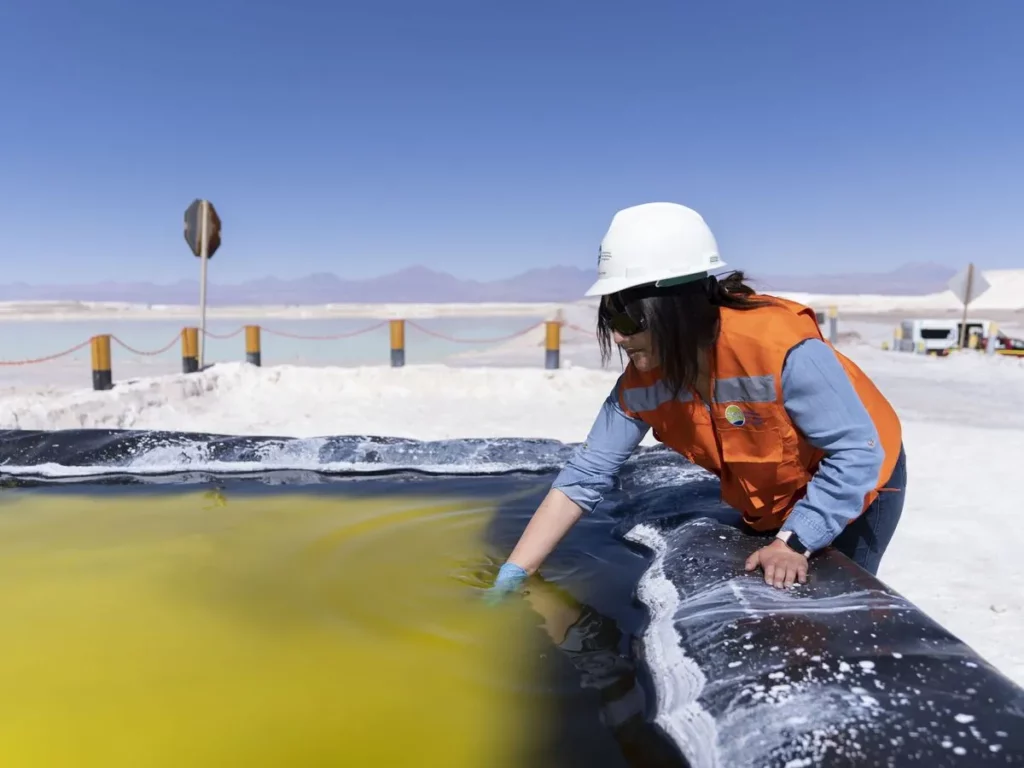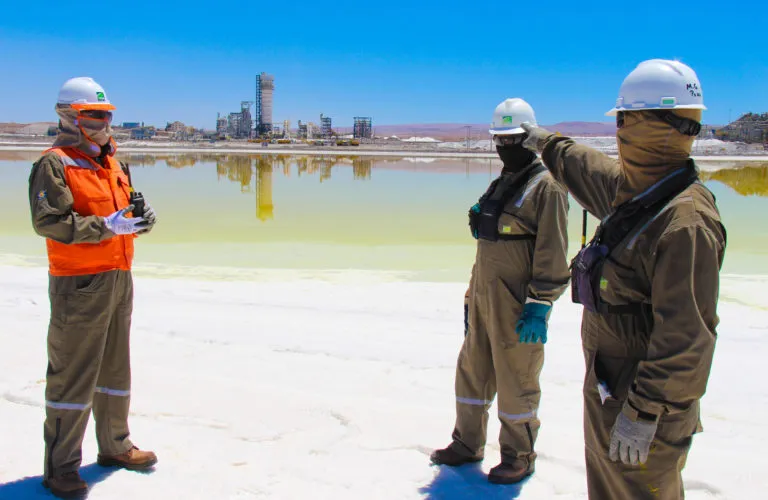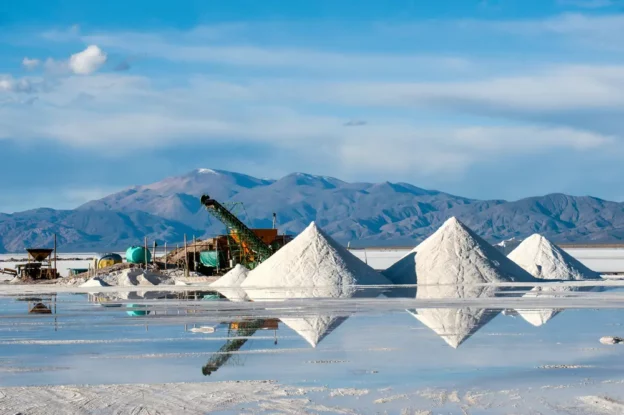The adoption of sustainable energy models is currently the main objective of the industrial sector, which is why lithium mining has emerged as a crucial component in the concept we know as “energy transition”. This metal, fundamental in the manufacture of lithium-ion batteries, can trigger essential technological advances for the decarbonization of transportation and the storage of renewable energy.
Its potential not only lies in being another resource for exploitation, but its extraction and production offer economic and technological development opportunities1. This article will explore in depth the operation of lithium mining and its impact on the energy sector, addressing the technical and strategic aspects that make it a key pillar in the global energy panorama.
What is lithium mining?
It is defined as a set of chemical processes that seek to isolate lithium from natural sources to convert it into a marketable form, commonly a stable compound such as lithium carbonate2. Lithium mining involves the extraction of lithium-rich minerals or brines, generally from underground deposits.

(Source: EFE/Adriana Thomasa)
The notable increase in lithium demand is mainly attributed to changes driven by the current global energy transition. Commitments to mitigate global warming include drastically reducing fossil fuels, expanding electrification, improving energy efficiency, and adopting alternative fuels.
Despite the abundance of lithium in land and sea sources, only some are economically viable today. However, with constant technological advances, a change is expected in this panorama, since new technologies are making extractions through alternative sources of lithium more competitive in terms of costs and efficiency, thus transforming the perception of lithium mining globally.
How do we mine lithium?
Lithium extraction is carried out through two main sources: Underground brine deposits and ore/spodumene extraction. Where each source has a specific extraction and processing process.
Extraction by underground brine deposits
This is the predominant process of commercial lithium extraction, which is carried out through brines, especially in the Lithium Triangle, a geographical area located on the borders of Bolivia, Argentina and Chile, as well as in China3.
The process begins with drilling into the ground to access underground reservoirs and pumping salt water to the surface, channeling it into evaporation ponds. Over several months and even years, the gradual evaporation of water results in the precipitation of various salts, increasing the concentration of lithium in the brine. Although simple, it is a lengthy procedure that culminates in obtaining lithium brines with a higher concentration of the element.
Once the optimal lithium concentration is reached, the brine is transferred to a lithium recovery facility by pumping to carry out the metal extraction process. This process can involve various stages, but the most common are:
- Removal of impurities or unwanted minerals.
- Precipitation of lithium and/or desired products through chemical treatment.
- Filtration to remove solids.
- Treatment with a reagent (such as sodium carbonate) to achieve the desired lithium form (lithium carbonate in this case). Depending on the target product, the treatment will have to be carried out with a specific reagent.
- Finally, the lithium obtained is washed and dried for sale.
Mineral/spodumene extraction
Compared to the aforementioned process, this lithium extraction process constitutes a relatively small fraction of global production, since, of more than 100 minerals that contain lithium, only five are actively exploited: Spodumene, lepidolite, petalite, amblygonite and eucryptite .
Despite having a greater wealth of lithium in brines, its extraction is much more expensive, because these materials have to be mined from rock formations, thus representing a greater expenditure of energy, chemicals and materials.
The process consists of extracting, heating and pulverizing the mineral obtained, and then combining the crushed powder with chemical reagents, such as sulfuric acid. The paste is subsequently heated to form lithium sulphate and insoluble residues3.
To eliminate the magnesium constituent of spodumene, lime is added, sodium carbonate is also added, the latter to precipitate lithium carbonate from the final already filtered solution.
Importance of lithium in the energy sector
Due to its properties, lithium is considered an essential component for the development of clean energy technologies. Its importance lies in the various crucial applications in which it can be implemented, such as lithium-ion batteries, electric vehicles and energy storage systems.
These types of batteries are mainly found in portable devices, electric vehicles and in grid energy storage, thanks to their high energy density, life cycles and recharge time. Lithium mining represents a pillar in the development of environmentally friendly transportation alternatives, as well as in the creation of energy storage systems, which can mean the effective integration of renewable sources into electrical networks.
The great demand for lithium is due to the fact that this mineral can be used in other clean technologies, such as wind turbines, since there are lithium-based materials used in the creation of lubricants and greases for these equipment4. Considering that the industrial world is pointing towards a sustainable future with the energy transition and clean technologies, lithium, thanks to its versatility of use, becomes an essential basis for the optimal development of these concepts that seek to guarantee a better future.
Environmental impact of lithium mining
- Depletion of water resources: The lithium extraction process through the evaporation method generates a large loss of water, since large volumes of brine (water with lithium and additional minerals) must be sacrificed to obtain a specific amount of the alkali metal. According to a study carried out by CONCINET researchers, approximately 584 thousand liters of water are needed to generate one ton of lithium.
- Salinization of soils and wetlands: Many of the regions rich in lithium have wetlands and sources of fresh water, however, the extraction of brine can cause an imbalance in these types of reserves by salinizing them. The soils can also be affected through this practice, thus harming the life of nearby communities, as well as the flora and fauna.
- Soil contamination by substances and waste: In order to obtain the key mineral, the brine tends to go through chemical treatment, and even if environmental considerations are taken, the flora, fauna and water sources are affected. The main reason is that these plants are not installed in an industrial environment, but are located in the middle of sensitive and unaltered ecosystems5. Additionally, once the lithium is obtained, the remaining concentrate is discarded, degrading and damaging the soil as a consequence.
Lithium extraction opportunities
Sustainable lithium mining projects

Taking into account that traditional lithium extraction processes can generate consequences in the ecosystem, one of the best opportunities results in the development of lithium mining projects that are environmentally friendly.
A clear example of this would be extraction through geothermal deposits that are rich in lithium. Commonly, these areas have geothermal plants for the generation of electricity, however, with the addition of purifiers to capture the mineral present in the steam from the deposits, these facilities would be helping in the supply of this important chemical element simultaneously. .
Lithium industrialization
With the overwhelming growth in demand for lithium to drive the energy transition, it is necessary to have a constant supply of the so-called “white gold” if effective decarbonization is to be achieved. Fortunately, companies belonging to various sectors are committed to this mineral and its projections for a sustainable future.
ExxonMobil is one of the companies that is committed to the adoption of lithium in the transportation transition and electrification process. For this reason, it has become one of the first oil and gas organizations to have lithium mining projects. Like this, many other companies have an interest in the mineral, so it is only a matter of time before we have an industrialized lithium system that will boost energy development.
Technological advances
Although lithium mining is an innovative concept in the energy sector, the truth is that extraction processes can be much more efficient and favorable for the environment. Currently, work is already underway on the development of new technologies that allow achieving better results.
Emerging lithium extraction methods
Direct Lithium Extraction (DLE)
Direct Lithium Extraction (DLE) is a practice that seeks to reduce the environmental impact, times and costs of lithium extraction compared to traditional practices.
This process consists of brine extraction to processing units where resins or adsorption materials are
implemented to retain the lithium chloride for further treatment and preparation6. These types of advances are of great importance for the constant obtaining of the mineral in a sustainable way for these delicate ecosystems.
Geothermal lithium extraction
The process begins with the pumping of lithium-rich geothermal fluids from subway formations
at high temperatures to the surface. There, extraction takes place, where the heat contained in the brine is used to drive turbines and generate electricity, subsequently, the fluid passes through a chemical separation system to extract the lithium through adsorption techniques, ion exchange or selective membranes.
Finally, the residual brine, now cooled and free of lithium, is reinjected into the geothermal reservoir, closing the cycle and ensuring the sustainability of the system.
Lithium recycling
The sequence to obtain recycled lithium starts with the controlled discharge of the exhausted
batteries, to avoid risks during handling. Then, they are disassembled and the physical separation of the cathode materials, which contain lithium.
Next, mechanical grinding is applied, which reduces the components to a homogeneous mixture
consisting mainly of metal oxides and graphite. This mixture constitutes the raw material for the subsequent stages.
Finally, through a complex hydrometallurgical process that uses chemical reagents and aqueous solutions to leach, extract and purify the metals present, lithium is separated at in the form of salts that can be used for the synthesis of new cathode materials. Although efficient, is a process that requires rigorous control to minimize environmental impacts.
Conclusions
Currently, lithium is considered one of the fundamental components in the transition towards sustainable energy models. Its crucial role in the manufacturing of lithium-ion batteries positions it as a key element for the decarbonization of transportation and the storage of renewable energy.
However, despite its prominent position in the energy transition, it poses significant environmental challenges, from the depletion of water resources to soil pollution. Despite these challenges, the insatiable demand for the mineral and the commitment of leading companies to develop sustainable extraction models demonstrate that the industrialization of lithium points the way to effective decarbonization.
With the implementation of sustainable lithium mining projects, and technological advances such as direct lithium extraction, a future is envisioned where this “white gold” effectively drives energy development at a global level. In this scenario, lithium will not only be an essential resource, but an engine that will drive the energy sector towards a more sustainable and efficient panorama.
References
- ECLAC (Economic Commission for Latin America and the Caribbean) (2023), Extraction and industrialization of lithium: opportunities and challenges for Latin America and the Caribbean. Retrieved December 15, 2023, from https://repositorio.cepal.org/server/api/core/bitstreams/8d505030-7686-44e1-9f60-77ceb0610826/content
- SAMCO Technologies (sf), What Is Lithium Extraction and How Does It Work? . Retrieved December 15, 2023, from https://samcotech.com/what-is-lithium-extraction-and-how-does-it-work/
- STT Engineering and Systems (sf), LITHIUM EXTRACTION. Retrieved December 15, 2023, from https://www.sttsystems.com/industries/lithium-extraction/
- Brunel (2023, June 26), Lithium: Energizing the Sustainable Future of Clean Energy . Retrieved December 16, 2023, from https://www.brunel.net/en/blog/mining/lithium-clean-energy
- Think Health (2023, September 22), THE ENVIRONMENTAL IMPACTS OF LITHIUM AND THE POSSIBLE TECHNOLOGICAL SOLUTIONS . Consulted on December 16, 2023, from https://www.ospat.com.ar/blog/impactos-ambientales-del-litio-y-las-posibles-soluciones-tecnologicas/
- CleanTech Lithium (n.d.), Direct Lithium Extraction. Retrieved December 17, 2023, from https://ctlithium.com/about/direct-lithium-extraction/

